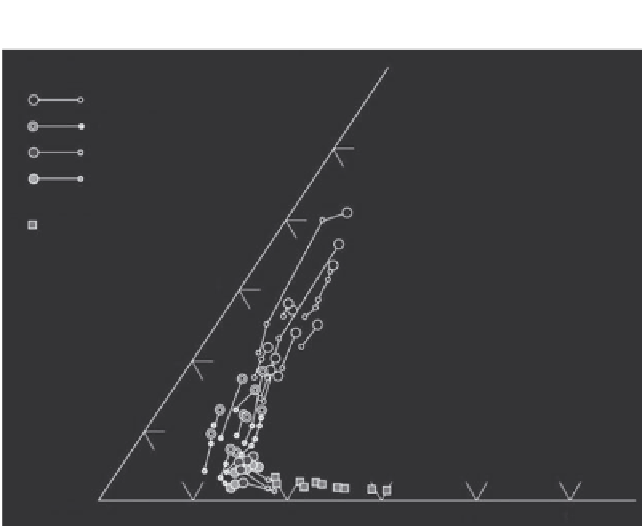Chemistry Reference
In-Depth Information
Mn (% at.)
Montagne Noire
Center
rim
garnet Zone
Staurolite Zone
andalusite/Kyanite Zone
Sillimanite + muscovite Zone
50
Agly massiv
Kinzigite
(high amphibolite facies
and granulite facies)
40
30
garnets in metapelites
prograde matamorphism of the southern slope
of Montagne Noire
(France, Herault, Tarn, Aude)
and
in the Kinzigites of the Agly massiv
(France, Pyrenees orientales)
20
10
Fe (% at.)
10
20
30
40
50
Mg (% at.)
Figure 3.32
Garnets in prograde metamorphism: example from southern slope of Mon-
tagne Noire and granulite massif Agly (Demange, 1982 and unpublished data).
The diagram shows that the tie-lines of the garnet-biotite-chlorite para-
genesis in the domain of medium pressure metamorphism, cross the tie-lines
of the cordierite-biotite-chlorite paragenesis in the domain of low pressure
metamorphism: metamorphism of rocks of the same chemical composition
produces cordierite schists at low pressure and garnet schists at medium
pressure.
Role of manganese in the appearance of garnet in metapelites
Thompson's diagram does not consider manganese but garnet often con-
tains a significant amount of this element. It is often assumed that garnet
is stabilized by the presence of manganese. This assertion must be nuanced
and discussed by considering the composition of the “normal” garnets; such
“normal” garnets, are the ones that the Thompson's diagram can explain
without requiring the presence of manganese (at a give chemical composi-
tion of the rock and a type of metamorphism).
In a prograde metamorphism, “normal” garnets show the following
evolution: the first garnets that appear at the isograd are rich in manganese
(and calcium). With increasing metamorphism, they become more and more





























